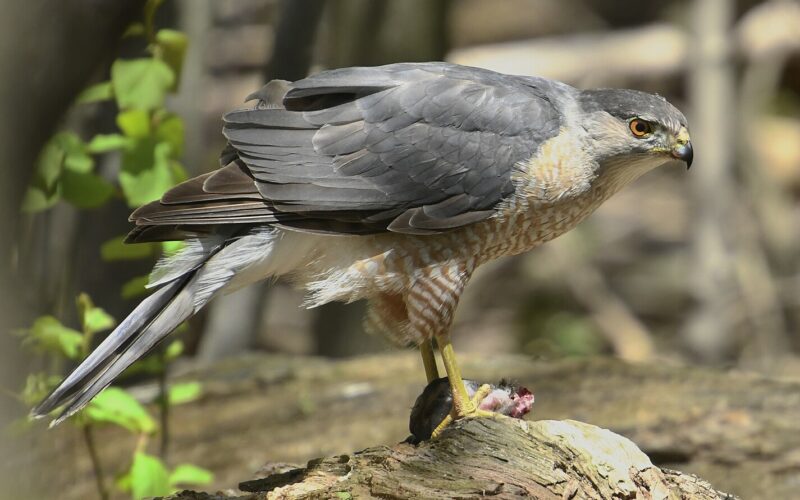Last Updated on January 20, 2024 by Greg Gillson
Did you see a brightly-colored red bird, orange bird, or yellow bird in Kansas and wonder what it was?
This page is for you!
This article shows you photos and identification of some of the most common birds in Kansas based on color.
The list of birds found in Kansas includes over 455 species. So, I can’t show you all of them. I’m going to assume that you saw a common bird of this color, but you certainly could have seen something less common, or even rare!
Shape (including the shape of the bill) and size are often more helpful in starting to identify a bird than the color. In fact, most birds in North American can be easily identified with a black-and-white photo!
Many birds are multi-colored, so that it may be hard to pick out a dominant color. Males and females may be colored quite differently. And some color patterns are similar among otherwise dissimilar species.
Nevertheless, I’m going to try to pick out some of the birds that you are most likely to see in backyards or towns. And I’ll show a few others that I get asked about a lot.
The birds with a noticeable amount of red on them in Kansas covered in this article are:
- Northern Cardinal
- American Robin
- House Finch
- Red-headed Woodpecker
- Ruby-throated Hummingbird
- Summer Tanager
The birds with a noticeable amount of orange on them in Kansas covered in this article are:
- Barn Swallow
- Baltimore Oriole
- Brown Thrasher
- American Kestrel
- Ruddy Duck
- Orchard Oriole
- Cooper’s Hawk
- Red-shouldered Hawk
The birds with a noticeable amount of yellow on them, including lots of yellow and black birds, in Kansas covered in this article are:
- American Goldfinch
- Northern Flicker
- Eastern Meadowlark
- Western Meadowlark
- Yellow-rumped Warbler
- Dickcissel
- Great Crested Flycatcher
- Western Kingbird
- Cedar Waxwing
- Yellow Warbler
- Northern Parula
- Common Yellowthroat
Red birds of Kansas
Birds get the red, orange, and yellow in their feathers from carotenoids in the fruit, seeds, and plants they eat (source).
These carotenoid colors combine with melanin to form an infinite range of red feathers–pink, rusty, scarlet, violet, red-orange.
The following are red birds that you are most likely to see in Kansas.
Northern Cardinal
These are one of the most common backyard birds in the eastern United States. Their bright red color and unique head profile makes them instantly identifiable to most people–whether they are bird watchers or not!
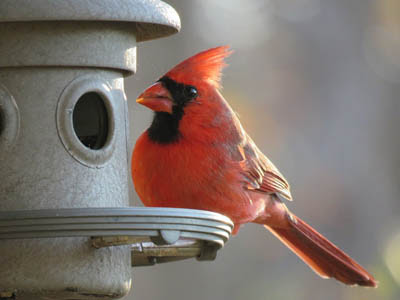 |
| Northern Cardinal. GeorgeB2 from Pixabay. |
Males of these large seed eaters are bright red with a black face and red crest.
Females replace most of the red with brown, The bill is large and orange.
These birds are found in woodlands, stream edges, residential areas.
Northern Cardinals are year-round residents throughout Kansas.
American Robin
These are familiar lawn birds with red breasts.
 |
| American Robin. Greg Gillson. |
Male American Robins are brownish-gray above with a brick red breast. Females are paler orange below and paler gray above.
They are widespread in open country with scattered deciduous trees, residential areas.
American Robins are year-round residents throughout Kansas.
House Finch
When people ask about a bird with a red head at their feeder, it is usually this bird.
 |
| Male House Finch. Greg Gillson. |
Males of this dusty brown striped finch have red limited to the head (specifically the forehead and eyebrow), breast (chest), and rump. The red coloration tends toward orangish, and may rarely be yellowish.
Females are streaked, similar to the males but without red. They lack any strong pattern on the face and head.
Note the small round head and curved upper ridge on the bill.
Some people call these red-headed sparrows. Sparrows and finches are similar, but in general, male finches are brighter than the females and tend to hang out more in trees. Sparrow genders are usually quite similar in coloration and tend to feed mostly on the ground.
These birds are common in residential areas, especially at bird feeders. In the West more widespread in arid regions near water.
House Finches are year-round residents in parts of eastern and central Kansas.
Red-headed Woodpecker
These well-known woodpeckers with red heads have a fitting name.
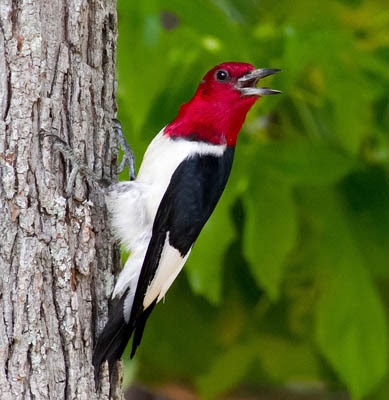 |
| Red-headed Woodpecker. Public domain. |
These birds have the entire head bright deep red. Back and tail black. Underparts white, as are inner secondaries and rump.
They are found in a variety of wooded habitats. They prefer to have oak and beech trees available. Sometimes come to feeders in winter.
Red-headed Woodpeckers are summer residents throughout Kansas, year-round residents in southeastern Kansas.
Ruby-throated Hummingbird
These red-throated birds are the only hummingbird nesting in the eastern United States.

Males are dark green above and on the belly. They have a white upper chest. The throat is ruby-red.
Females are green above, white below, including white throat.
These birds are found in woodland edges, residential yards. Readily come to hummingbird feeders.
Ruby-throated Hummingbirds are summer residents in southeastern Kansas, spring and fall migrants throughout.
Summer Tanager
These bright red birds are found toward the tops of tall trees in the southern United States.

Males are rose red with fairly heavy bill.
Females are yellowish or mustard-colored, some with a faint reddish wash.
In the East these birds are found in pine-oak woodlands. In the West they prefer tall cottonwood trees.
Summer Tanagers are summer residents in southeastern Kansas.
Orange birds of Kansas
True orange-colored birds are not that common. Many birds that I have here are paler rusty.
The common pattern is an orange body and black or brown wings and tail. Another common pattern is for the orange to be restricted to the under parts.
The following are orange birds that you are most likely to see in Kansas.
Barn Swallow
These orange-bellied birds are a familiar sight across North America in summer.
 |
| Barn Swallow. Greg Gillson. |
These birds are purple-blue above with orange under parts and long forked tails. The color of the underparts in winter or on females are often cinnamon or buff-colored, but breeding males can be brighter orange-red.
These birds swoop low over fields and wetlands at lower elevations. They may build their mud nests in rafters on porches, garages, or other out-buildings.
Barn Swallows are summer residents throughout Kansas.
Baltimore Oriole
These bright orange and black birds are fairly common breeders in wooded areas in the East.
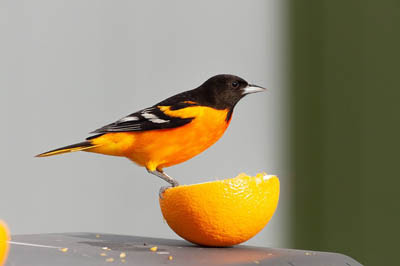 |
| Baltimore Oriole. Michael McGough. Pixabay. |
Males have a black hood and back. Wings black with white patches. Tail black with orange sides to the base. Bright orange under parts.
Females are similar to males, but more olive above, less black. Immature birds for their first year or more are olive above orangish-yellow on the breast, fading to yellow on the belly. Two white wing bars.
These birds are common in deciduous woods, shade trees.
Baltimore Orioles are summer residents in most of Kansas, but spring and fall migrants only in southwestern Kansas.
Brown Thrasher
These are rather large rusty-orange songbirds.
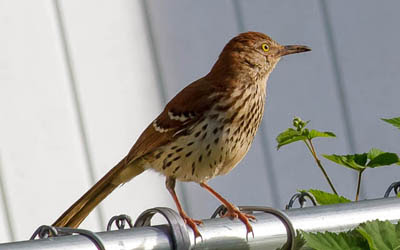 |
| Brown Thrasher. Linda Jones CC0. |
The upper parts of these birds are colored rusty-brown to orange. They show two white wing bars. Under parts are buff with heavy reddish-brown streaking.
These birds live in woodland edges and mature backyard landscaping.
Brown Thrashers are summer residents throughout Kansas.
American Kestrel
These are the familiar small rusty-orange falcons sitting on power lines on the edge of the highway, or hunting and hovering over the median strip.
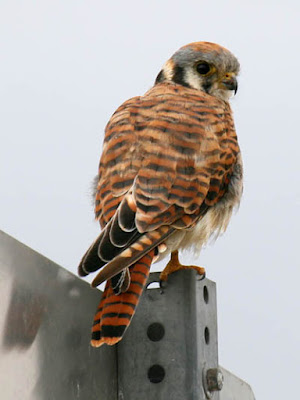 |
| Female American Kestrel. Greg Gillson. |
Females are rusty orange barred with black on their back wings and tail. The under parts are buff with black spots. The head shows two facial stripes.
Males have blue-gray backs and rufous tail is unmarked except for black tail band.
These birds are found in open country, farms, pastures with perches.
American Kestrels are year-round residents throughout Kansas.
Ruddy Duck
These small ducks are dark rusty-orange in spring.
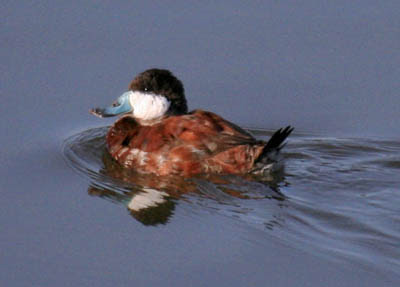 |
| Ruddy Duck. Greg Gillson. |
Males in breeding plumage (late winter and spring) are rusty, with a white face, and a blue bill. The long tail is often held sticking up. In winter they are brown, with white face, and dark bill.
Females all year are like winter males. Brown body, dark cap, dark line through eye of pale face. Dark bill.
These birds prefer weedy ponds to breed, but in winter may be found in deeper ponds in city parks.
Ruddy Ducks are summer residents in northwestern Kansas, spring and fall migrants throughout.
Orchard Oriole
Males of these orioles are darker rustier-orange than most other orioles in the United States.
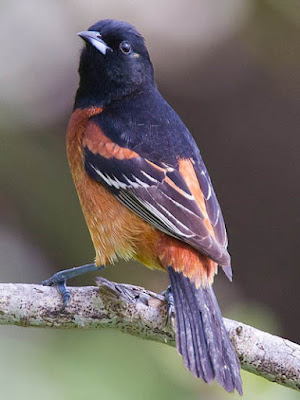 |
| Orchard Oriole. Dan Pancamo. Flikr. CC BY-SA 2.0 |
Males have a black hood and back, black wings and tail. The under parts are rusty-orange or even chestnut-brown.
Females are greenish above, lemon yellow below. They have 2 thin white wing bars. The bill is thinner than many other orioles.
They are found in orchards and residential shade trees.
Orchard Orioles are summer residents throughout Kansas.
Cooper’s Hawk
These crow-sized hawks with reddish orange bars on the under parts may show up in fall or winter to hunt birds at your feeder. Oh no!
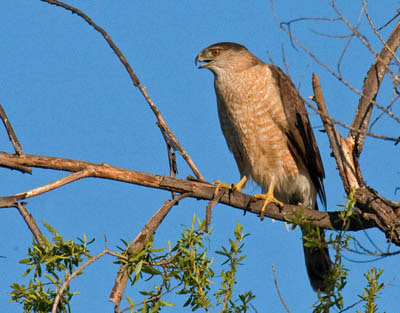 |
| Cooper’s Hawk. Greg Gillson. |
Adults with long gray and black banded tail. Dark gray above and cap on head. Under parts barred with rusty orange.
Immatures similar, brownish, streaked with brown on under parts.
Found in forests and woodlands, residential shade trees.
Cooper’s Hawks are year-round residents throughout Kansas.
Red-shouldered Hawk
Okay, the shoulders are reddish. But the rusty-orange breast and wing linings are barred red too.
 |
| Red-shouldered Hawk. Greg Gillson. |
The upper parts are barred black and white. The tail is banded black and white. In adults the breast is barred orange.
Immature birds are streaked with brown on the breast.
These birds like woodland edges, residential edges, riparian groves.
Red-shouldered Hawks are year-round residents in eastern Kansas.
Yellow birds of Kansas
Yellow is a common bird color! Often it is mixed with black and white plumage in birds.
Many birds with darker upper parts have yellow breast or belly.
The following are yellow birds you are most likely to see in Kansas.
American Goldfinch
These small little birds are bright yellow and black.
 |
| American Goldfinch. Greg Gillson. |
Males are bright lemon yellow with black and white wings and tail, black cap. White under tail coverts. Pink bill.
Females are duller yellow below and brownish above. Lack black cap.
Winter birds are pale brown or gray, a touch of yellow on the throat of males.
These are birds of open country, fields with saplings, clear cuts, residential areas. They avoid dense forests, mountains, deserts. They visit feeders.
American Goldfinches are year-round residents throughout Kansas.
Northern Flicker
These woodpeckers spend much time eating ants on the ground.
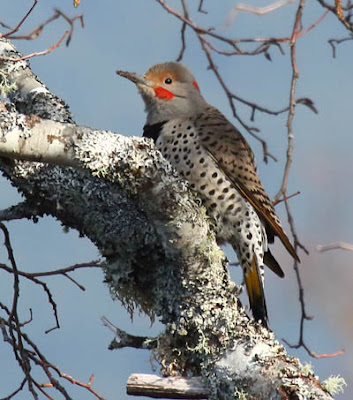 |
| Northern Flicker. Greg Gillson. |
These birds are larger than robins with brown and black barred upper parts. The underparts are pink with round black spots. There is a black crescent across the chest. When they fly away from you they reveal a large white rump.
Western birds have salmon-red under wings and under tail. Those in the East are colored yellow. The male face differs between the two populations–black whisker on the eastern birds, red whisker on western birds. Intergrades from overlap on Great Plains common. These may show male facial characteristics of both populations, or yellow-orange flight feathers.
These birds live in open woods with bare ground for foraging, residential yards.
Northern Flickers are year-round residents throughout Kansas.
Eastern Meadowlark
These pale brown birds with the brilliant yellow breasts are home on the ground in prairies. They sing from perches on isolated trees, power poles, fence posts.
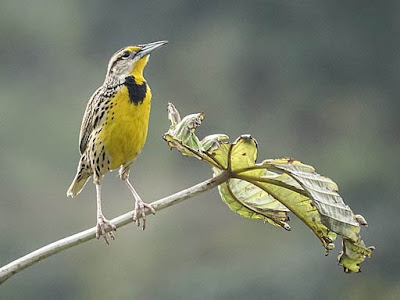 |
|
Eastern Meadowlark
Photo by Mike’s Birds from Riverside, CA, US [CC BY-SA 2.0]
|
The upper parts are streaked black, white, brown, so they blend into the dried grass where they live. The under parts are bright yellow with a black necklace across the chest. Very similar to Western Meadowlark, best told apart by spring song.
These birds live in prairies and extensive pasture lands.
Eastern Meadowlarks are year-round residents in eastern and southern Kansas.
Western Meadowlark
These are streaky camouflaged prairie birds from above or from behind. But from the front, the breast is shocking yellow!
 |
| Western Meadowlark. Greg Gillson. |
They are streaked brown, black, and gray on the upper parts. The underparts are golden yellow with a black necklace crossing the upper breast. Much paler yellow in fall and winter, as the yellow feathers are tipped with white and streaked with brown.
These are birds of pastures and grasslands and arid regions.
Western Meadowlarks are year-round residents throughout most of Kansas, winter visitors only in southeastern Kansas.
Yellow-rumped Warbler
These are abundant warblers across North America. Affectionately called “butter butts” by many birders, because of their bright yellow rumps that flash in flight.
 |
| Myrtle Yellow-rumped Warbler. Greg Gillson. |
Western form (Audubon’s) with bright yellow throat and yellow rump. Large white wing patch.
Northern and Eastern form (Myrtle) with white throat, yellow rump, and two white wing bars.
Winter birds are dull gray brown, with bright yellow rump. Throat may be cream colored or white. Often difficult to tell the two forms apart in winter.
 |
| Winter Yellow-rumped Warbler. Greg Gillson. |
Breed in mountain or boreal conifers. Widespread in migration. Winter in low river bottoms, open weedy deciduous areas. Rarely come to feeders in winter.
Yellow-rumped Warblers are spring and fall migrants throughout Kansas, winter visitors in southeastern Kansas.
Dickcissel
These yellow birds often flock together in weedy roadside edges.
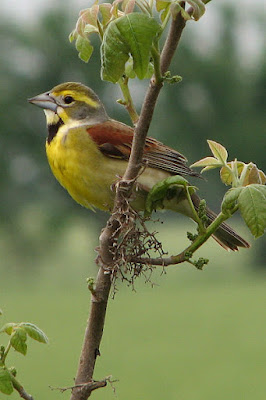 |
| Dickcissel. RebelAT. CC By-SA 3.0 |
These are gray birds with yellow breast and eyebrow.
Males have a black band across the lower throat. They have a large chestnut patch on the shoulder.
Females paler, lack black chest band.
They are found in prairie grasslands and weedy patches.
Dickcissels are summer residents throughout Kansas.
Great Crested Flycatcher
These flycatchers have long tails and big heads with big bill and bright yellow belly.
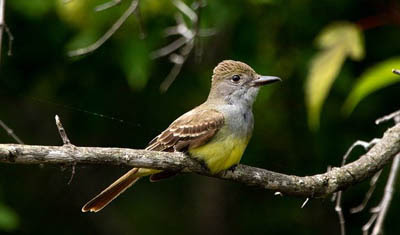 |
| Great Crested Flycatcher. Simard Francois. Pixabay. |
These birds are gray on the face and breast, brownish on rest of upper parts. Bright lemon yellow belly. The under side of the tail and some feathers of the wing are cinnamon colored.
These birds stay in the canopy of open woods.
Great Crested Flycatchers are summer residents throughout most of Kansas.
Western Kingbird
These yellow-bellied birds of the prairies often perch on power lines and fence lines.
 |
| Western Kingbird. Greg Gillson. |
These birds are pale gray on the head and breast. Brown wings. The belly is lemon yellow. Black tail has white outer tail feathers, especially obvious in flight.
These are birds of prairies, deserts, pastures, often near water.
Western Kingbirds are summer residents in western Kansas.
Cedar Waxwing
These crested birds with yellow band on the end of the tail are often found in flocks. They eat flying insects in summer, fruit and berries the rest of the year.
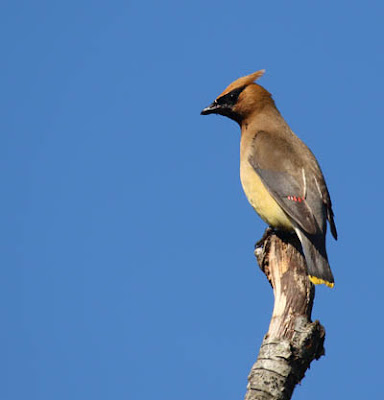 |
| Cedar Waxwing. Greg Gillson. |
These birds are fawn-brown above, with dark gray wings and tail. They have a black mask and wispy crest. The belly is yellow. The wings have waxy red drops on the end of the tertials. The end of the tail has a brilliant yellow tail band.
They are found in open habitats with berries, including juniper woodlands and towns in winter.
Cedar Waxwings are winter visitors throughout Kansas, year-round residents in northeastern Kansas.
Yellow Warbler
The golden yellow sun packed all into one little bird! Appears to be an all-yellow bird.
 |
| Yellow Warbler. Greg Gillson. |
Some populations are bright yellow, some tend toward greenish on upper parts, some more golden. Yellow internal tail corners in flight.
Males with red breast streaking, again, variable by population.
Females somewhat to much paler yellow, some greenish, some whitish. Lack red streaks.
These birds are found in willow thickets on the edge of wetlands and ditches, stream sides in arid regions.
Yellow Warblers are summer residents throughout Kansas.
Northern Parula
This is a handsome blue and yellow warbler.

Males are blue on the hood and shoulders. Back green. Yellow throat and breast with a dark red spot mid-chest. Broken white eye ring. Two wide white wing bars.
Females are similar, but paler.
They are found along streams and in swampy forests with willows, maples, birches, hemlocks and other trees.
Northern Parulas are summer residents in eastern Kansas, spring and fall migrants through the middle of Kansas, absent in the west.
Common Yellowthroat
These buttery yellow birds are abundant in the marsh vegetation.
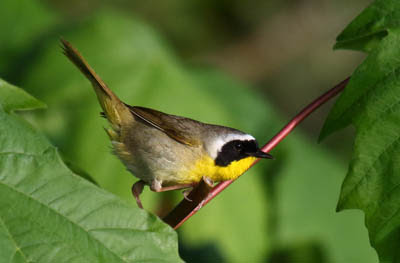 |
| Male Common Yellowthroat. Greg Gillson. |
These skulkers have bright yellow throats and yellow undertail coverts. Males have a black domino mask edged broadly in white, which females lack. Upperparts are dull olive-green.
Immature males in fall show a shadowed black mask.
Found in damp situations and heavy deciduous brambles following clear cuts.
Common Yellowthroats are summer residents throughout Kansas.
Wrapping Up
Kansas has some lovely red, orange and yellow birds but it also offers some other stunning birds. Here is a pick of my favorites.
Blue Grosbeak: These stocky buntings with deep blue bodies and chestnut wings inhabit dense vegetation like thickets and brushy fields, offering glimpses of their striking plumage.
Cerulean Warbler: These tiny blue warblers with white wing bars favor tall trees in mature forests, offering fleeting glimpses of their sky-like plumage.
Pine Warbler: These agile warblers with yellow bodies and green wings flit among pine branches, searching for insects and uttering their high-pitched “zee” calls.
Painted Bunting: Males in breeding plumage sport a dazzling combination of blue, green, red, and yellow, making them one of the most colorful birds in North America.
Mississippi Kite: These graceful raptors with gray bodies and long, pointed blue-gray wings soar high above open fields and wetlands, searching for prey.
Frequently Asked Questions
What is Kansas red headed bird?
The Red-headed Woodpecker is a beautiful bird with a bright red head and black and white body, but unfortunately, their populations in Kansas have declined significantly in recent decades. Finding them can be a bit challenging, but not impossible! Here are some places where you might have the best chance of encountering these charismatic birds in Kansas:
Habitat:
- Open woodlands: Look for them in scattered trees, groves, and edges of forests, especially with dead or decaying trees where they find insects.
- Farms and orchards: They readily visit farms and orchards for insects and fruits.
- Backyards and residential areas: If you have large trees and offer suet feeders, they might occasionally visit.
Location:
- Western Kansas: Populations are generally higher in the western part of the state, particularly along the Smoky Hill River Valley and in the foothills of the Rocky Mountains.
- State parks and protected areas: Places like Cheyenne Bottoms Wildlife Area, Quivira National Wildlife Refuge, and Tallgrass Prairie National Preserve offer suitable habitat and conservation efforts.
Are Orioles in Kansas?
Yes, Orioles are definitely in Kansas! Two species of oriole are common in the state:
- Baltimore Oriole: This iconic orange and black bird is the most widespread oriole in Kansas, gracing open woodlands, parks, and backyards with its vibrant plumage and melodious songs. They arrive in late April or early May and stay until late August or September.
- Orchard Oriole: These slightly smaller birds with a chestnut red body and black head favor wooded edges, orchards, and parks. They are less common than Baltimore Orioles but can still be found throughout Kansas during their breeding season from late April to early September.
Where can I find Great Crested Flycatcher in Kansas?
While Great Crested Flycatchers aren’t considered common breeders in Kansas, they can be found in the state during migration seasons and occasionally as summer residents. Here’s where you might have the best chance of spotting these striking birds:
Habitat:
- Wooded edges: Look for them along the edges of mature deciduous forests, especially with open areas nearby for hunting insects.
- River corridors: They often follow riparian habitats along rivers and streams, finding suitable perches and abundant prey.
- Parks and large backyards: If you have large trees and open spaces in your backyard, you might be lucky enough to attract them during migration.
Location:
- Eastern Kansas: They are more likely to be found in the eastern part of the state, particularly near wooded edges bordering tallgrass prairies.
- State parks and protected areas: Places like Cheyenne Bottoms Wildlife Area, Tallgrass Prairie National Preserve, and Marais des Cygnes National Wildlife Refuge offer suitable habitat and attract migrating birds.
Related Articles:
Most common backyard birds in Kansas
Birds at your feeder in Kansas
Birds with red heads in North America.
Yellow-and-black birds in North America.






